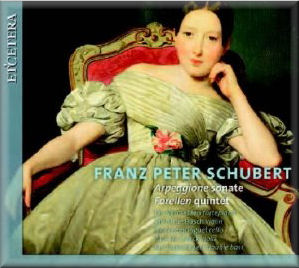 |
 |
|


alternatively
CD: MDT
AmazonUK
AmazonUS
Sound
Samples & Downloads |
Franz SCHUBERT (1797-1828)
Arpeggione Sonata in A minor, D821(1824) [24:51]
Trout Quintet in A major, D667 (1819) [41:59]
 Jan Vermeulen (fortepiano), Christine Busch (violin), Paul de Clerck
(viola), France Springuel (cello), Jan Buysschaert (double bass)
Jan Vermeulen (fortepiano), Christine Busch (violin), Paul de Clerck
(viola), France Springuel (cello), Jan Buysschaert (double bass)
rec. December 2010, April 2011, Chambermusic Hall of the Lemmens
Institute, Leuven, Belgium. DDD
 ET’CETERA KTC 1431 [66:50]
ET’CETERA KTC 1431 [66:50] 
|
|
|
This coupling of the Arpeggione Sonata and the Trout
Quintet brings together two of Schubert’s sunniest and most
melodic chamber works, in irresistible performances.
The sonata, as its name suggests, was written for the arpeggione,
an instrument that resembled a cross between a guitar and a
cello. The arpeggione had gone out of favour by the time Schubert’s
sonata was published in 1871; today the work is usually performed
on the cello. It is a spacious work with a placid Allegro
moderato, a brief Adagio and an Allegretto finale
in rondo form. The Arpeggione is not as tightly constructed
as the cello sonatas of Brahms, having a tendency to meander,
but its melodic flow is ceaseless and its mood generally pastoral.
The Arpeggione presents numerous difficulties when playing
the work on a modern cello. There are sustained passages which
lie very high, together with some awkward leaps. In this recording
France Springuel uses a five string cello piccolo, a modern
copy of a 17th century Italian instrument. According
to the liner-notes this both equates to the tone of the arpeggione
and reduces the technical problems encountered on the modern
cello. The pianist, Jan Vermeulen, plays an original 1826 Streicher
fortepiano. This combination has quite a different sound to
a modern instrument duo, being softer and tonally less penetrating;
to compensate, there is an increase in intimacy that suits the
work very well.
France Springuel’s instrument has a small but rather silvery
sound; the bottom strings are quite resonant, but the harmonics
don’t ring out as on a modern cello. Her fine legato playing
and discriminating use of vibrato create a soulful, rather inward
mood in the slow movement. Springuel makes the most of her cello’s
tonal resources; at the beginning of the finale, for example,
she plays a little closer to the bridge to add intensity. The
more brittle sound of the fortepiano helps the duo to achieve
a better balance by comparison with most modern instrument performances.
Credit should also be given to Vermeulen in generously supporting
the solo line. This is a cultivated yet fully emotionally realised
performance; it would not be out of place in a domestic setting
such as the “Schubertiades” in which much of Schubert’s music
was first heard.
Mstislav Rostropovich’s 1968 recording of the Arpeggione
with Benjamin Britten was reissued on Decca in their Legendary
Recordings series in 1999 together with the Five pieces in
folk style by Schumann and the Sonata by Debussy. Theirs
is a memorable collaboration; Rostropovich’s large and beautiful
sound is underpinned by Britten’s discreet accompaniment. This
is more a performance for the concert hall, in the grand manner,
taking over four minutes longer than Springuel and Veurmeulen.
The Trout takes its name from the fourth movement, which
is a set of variations on a theme from Schubert’s song Die
forelle, D 550. The unusual instrumentation, featuring a
double bass in place of a second violin, stems from its being
commissioned by the amateur cellist Sylvester Paumgartner, who
wanted a work with the same instrumentation as the quintet arrangement
of Hummel’s Septet, op. 74. The presence of the double bass
frees the cello from its usual role as a bass instrument, allowing
Schubert to treat it as a melodic instrument in the ensemble.
Schubert also gave the piano quite a deal of octave writing
high in the treble, to counterbalance the two bass instruments.
The first movement of the quintet begins in vivacious style,
and settles into an ideal tempo, animated yet relaxed. The dynamics
are nicely shaped, and the ensemble playing is extremely sensitive.
The duo playing between the strings is quite delightful in the
second movement; the violinist is perhaps a little recessive
from time to time. The third movement is taken at a fairly brisk
tempo, and maintains the rhythmic tautness of the previous movements.
The “Trout” theme floats in beguilingly at the beginning of
the fourth movement. The violin accompanies the viola and cello
selflessly in the second variation, while the left hand of the
fortepiano is thunderous in the minor variation. The finale
begins - like its counterpart in the B flat major sonata D 960
- with an octave in the fortepiano. The question-and-answer
phrases are not rushed or bitten off at the ends, as is often
the case, and the ensemble generates quite a deal of energy
in the long crescendos. There is no star in this show to be
accommodated; everyone is as happy to accompany as to take the
melody. This is that rarity among recordings, one which sounds
like a group of friends playing together for sheer enjoyment.
The fortepiano seems a little more forward in the balance than
in the sonata, which helps its small sound to be heard. The
recording has a natural effect in an acoustic that complements
such fine playing.
Competition is intense among recordings of this mainstay of
the chamber repertoire. Emil Gilels recorded the Trout
with members of the Amadeus Quartet in 1976. That performance
has all the vigour and energy one would expect, yet by comparison
with Vermeulen and his ensemble it is rather hefty. After hearing
this performance, one comes away with the feeling that the original
instruments have a definite advantage in terms of balance, and
achieving a blend that is less tiring to the ear.
Guy Aron
|
|

